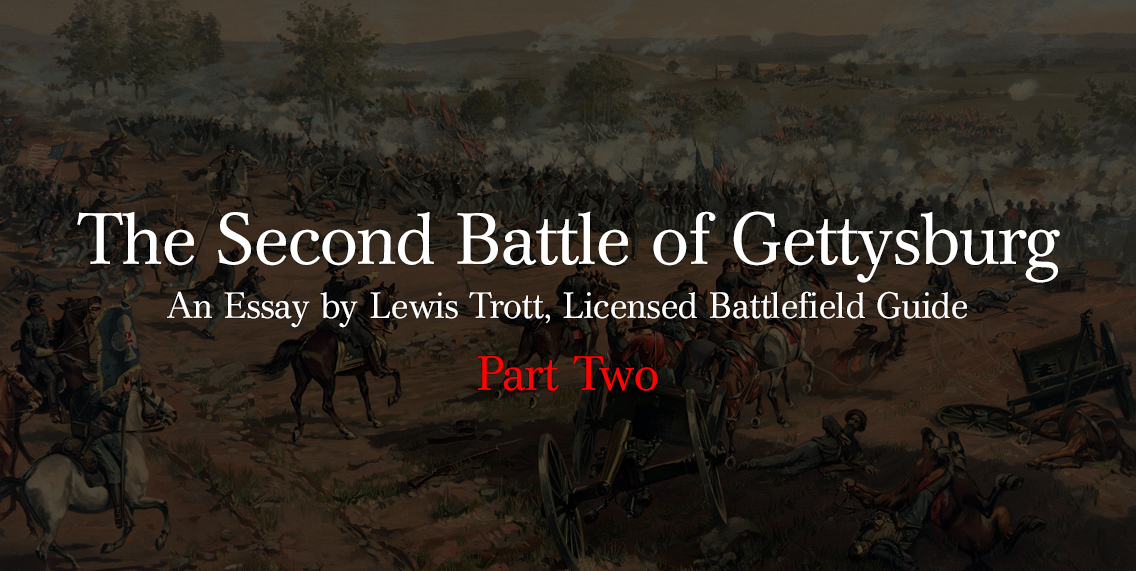
28 Mar The Second Battle of Gettysburg, Part Two
By Lewis Trott, Licensed Battlefield Guide, Gettysburg National Military Park
Maj. Gen Sickles would only serve in active command under Maj. General Meade for five days, and yet these five days would shape a controversy that lasts until today. Whether through willful disobedience or mis-interpretation or just plain lack of respect for the particular chain of command he fell under at the time, Maj. General Sickles famously moved his III Corps forward from his assigned line to the Emmitsburg Road. Of the plan to fight at Gettysburg, there was no apparent doubt in the mind of Sickles, as he would testify:
“I addressed a written communication to General Meade, begging him by all means to concentrate his army there (Gettysburg) and fight a battle, stating that in my judgment it was a good place to fight; that the position of General Howard was an admirably chosen one, and that the enemy would undoubtedly mass there in great force, and that in my judgment it would be most destructive to the morale of the army to fall back as was apparently contemplated in his order of that morning [the Pipe Creek circular]” [1]
The idea that Meade did not want to fight at Gettysburg even after ordering the army to concentrate there began to grow and formed one of the main charges levied against the commander by his detractors on the Committee.
After riding to Meade’s headquarters on the morning of July 2 in search of orders in placing his Corps, Sickles testified that “I was satisfied, from information which I received, that it was intended to retreat from Gettysburg”. [2] If indeed Sickles first got wind of a retreat at this point or six months later, the idea no doubt came from Major General Daniel Butterfield, the hold over chief of staff from Major General Hooker’s staff. Maj. General Butterfield seemed to take the instructions from Meade to familiarize himself with the various roads in the Gettysburg area as well as the positions of the various Corps, “so that in the event of any contingency, you can, without any order, be ready to meet it” [3], to mean that the commander was preparing to order the retreat of the AOP from Gettysburg. Whether or not Butterfield was being ingenuous in his remembrances or simply ignorant of reality, he provided anyone with an axe to grind against Meade ample fodder with which to try and prove his overall lack of decisive leadership.
Maj General Sickles would further state that “I have reason to know that his [Meade’s] plan of operations was changed again on Thursday [July 2], and that he resumed, in substance, the plan that he had on Wednesday morning, which was to fall back to Pipe Creek, or to some place in that neighborhood.” [4] Since Maj. General Sickles spent much of the morning of July 2 in apparent confusion about what his actual orders or lack thereof were, it is a fair assumption the information suggesting a retreat on the morning of July 2 came from Maj. General Butterfield once the knives began to flash towards Maj. General Meade. It was Butterfield who made it known that Meade was ready to retreat on the morning of July 2, even as he tried to prepare the forces on the right of the AOP line to attack.
Of course Maj. General Sickles eventually placed his Corps in a position where he stated “fortunately, my left had succeeded in getting on Round Top and along the commanding ridge to which I had referred (the Emmitsburg road line); and those positions were firmly held by the 3d Corps.” [5] Sickles was not the only witness to claim the left of his line was on “Round Top”. When division commander Major General David Birney testified on March 7, 1864, he stated that his division “took position with my left at and on Round Top” [6]. Birney also made the rather scurrilous claim that when he asked for support from the V Corps after it became apparent that the Confederates were going to attack the left of Sickles line, Birney received the message from a V Corps staff officer from whom he requested support that “his men were making coffee and were tired, but that he would be up in time.” [7]Birney stated that “I held my division from Round Top to the Emmettsburg (sic) Road,” [8] again implying the occupation of what we now call Little Round Top. To gauge whose camp Maj. General Birney was in, one only needs to look to what Maj. General Hooker had to say in March of 1863 in questioning Secretary of War Edwin Stanton on whether or not then Brig. General Birney had been passed over for promotion: “He now commands Kearney’s old division, and a better division commander is not in this army.” [9]
__________________________________________
[1] Report of the Joint Committee on the Conduct of the War at the Second Session Thirty-Eighth Congress. Washington: Government Printing Office,1865, Page 297
[2] Ibid, 298.
[3] Ibid, 436.
[4] Ibid, 299.
[5] Ibid, 299.
[6] Ibid, 366.
[7] Ibid, 367.
[8] Ibid.
[9] Ibid, 200.
No Comments